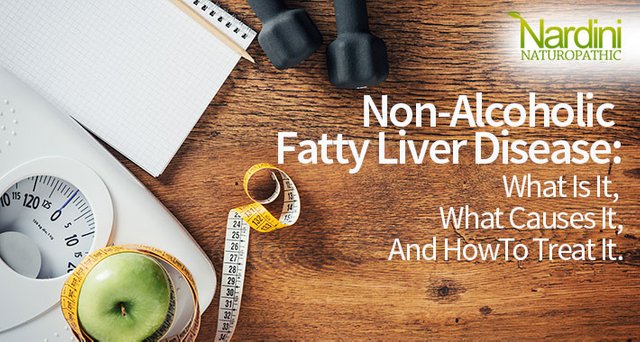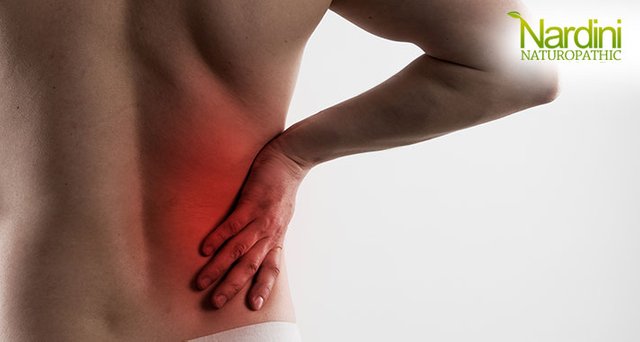Non-Alcoholic Fatty Liver Disease: What Is It, What Causes It, And How To Treat It - Dr. Pat Nardini, Naturopathic Doctor

This article was written by Dr. Pat Nardini, a naturopathic doctor in Toronto and owner of the Nardini Naturopathic clinic. It appears here on Steemit with the full permission of the original source. To find out more about Dr. Nardini, visit his website here - http://www.nardininaturopathictoronto.com
Your liver weighs only about 3 pounds, but it’s easily one of the most important organs in your body.
It sits just to the right of your belly, behind your ribcage, just above your gallbladder, pancreas, and intestines.
It acts as a filter, cleaning the blood, detoxifying chemicals, and processing and absorbing any drugs that come through your digestive tract.
You have a few organs without which you can still continue to live.
This includes organs you have more than one of, like your lungs or kidneys, where the remaining organ can work harder to pick up the slack.
But there are other organs, like your appendix, spleen, colon, and even your stomach, which can be entirely removed without risking your survival (optimal health is another matter).
Your liver is not one of these organs.
Without a liver, most experts agree you’ll be dead within a few days.
They don’t call it a liver for nothing.
There are a number of different disorders that can affect the liver.
As a naturopathic doctor with a special interest in treatments for endocrine disorders, I’ve taken an interest in liver disorders as well.
While your liver isn’t directly considered a part of your endocrine system, it does have some secondary endocrine functions, so it can influence how your endocrine system functions.
What I’d like to talk about today is non-alcoholic fatty liver disease, or NAFLD.
What Is Non-Alcoholic Fatty Liver Disease?
The fact that it’s named “non-alcoholic fatty liver disease” implies that there’s an “alcoholic fatty liver disease,” and this is true.
Alcoholic fatty liver disease is caused by, as the name suggests, heavy alcohol use.
When you drink alcohol, it’s your liver’s job to break the alcohol down so your body can dispose of it safely.
But while your liver breaks the alcohol down, it creates harmful substances as a by-product, which can damage the cells of your liver and cause inflammation.
The more you drink, the worse the effect is.
If left untreated, alcoholic fatty liver disease may progress to alcoholic hepatitis, and then cirrhosis, and sometimes even liver cancer.
Non-alcoholic fatty liver disease functions similarly, except the cause is not alcohol.
The phrase is actually an umbrella term which refers to a number of different liver conditions that people who either don’t drink, or drink moderately, may deal with.
The unifying characteristic, though, is that too much fat is stored in the liver.
When excess fat is stored in the liver, it can hinder your liver from working properly.
Symptoms Of Non-Alcoholic Fatty Liver Disease
One of the disturbing things about non-alcoholic fatty liver disease is the fact that often there are no symptoms at all associated with it until it gets far worse.
When there are symptoms, they may include:
• Unexplained and chronic fatigue
• Pain in the liver (upper right abdomen)
• An enlarged liver
Advanced forms of non-alcoholic fatty liver diseases may have more obvious symptoms, such as:
• Jaundice (yellowing of the skin)
• Enlarged blood vessels
• Enlarged spleen
• Enlarged breasts (in men)
• Abdominal swelling
• Red or discoloured palms

Risk Factors Of Non-Alcoholic Fatty Liver Disease
In Canada, the most common cause of non-alcoholic fatty liver disease is obesity.
According to research from the Canadian Liver Foundation, up to 75% of obese individuals are at risk of developing some sort of fatty liver disorder.
Another common cause of fatty liver can be nutritionally-based.
Malnutrition and starvation can cause fatty liver, as can rapid weight loss.
If you’ve been receiving nutrients via infusion directly into the bloodstream for an extended period of time, you may be at greater risk of developing a fatty liver disorder as well, as are those who have received an intestinal bypass surgery to combat obesity.
Some other disorders have been associated with NAFLD as well.
A 1990 study by Wanless and Lentz found NAFLD was present in nearly 100% of patients with both type II diabetes and obesity.
Insulin resistance, high blood pressure, and hyperlipidemia are other associated conditions.
There are genetic factors at play as well, as are the presence of certain chemicals.
The older one gets, the more they seem to be at risk.
While NAFLD can show up in any age group, those in their 40’s and 50’s who exhibit one or more of the above risk factors seem to be more at risk.
Other risk factors include:
• PCOS (polycystic ovarian syndrome)
• Sleep apnea
• Hypothyroidism
• Hypopituitarism
• Metabolic syndrome
• High cholesterol
Cirrhosis
Cirrhosis is the most common complication associated with NAFLD.
Cirrhosis is consistent scarring of the liver. As the liver works to stop the inflammation associated with NAFLD, it can end up scarring itself.
Minor and limited scarring is not terribly concerning, but if left unchecked, the scarring will spread more and more across your liver tissue.
This can lead to complications, including esophageal varices, hepatic encephalopathy, ascites, liver cancer, and, in the most extreme situations, complete liver failure.
How To Prevent NAFLD
There are a number of different ways you can reduce your risk for fatty liver disease, both alcoholic and non-alcoholic, and its associated disorders.
Read on to discover what they are.
1. Reduce your alcohol intake
This is probably the most obvious of all.
The fact that alcohol is damaging to the liver is commonly known even outside the healthcare industry.
Obviously from a health perspective, eliminating alcohol altogether is the best option, but if you do decide to drink, try to limit it to no more than one drink per day.
2. Maintain a healthy weight
Since the most common association with NAFLD is obesity, maintaining a healthy weight is one of the best ways to reduce your risk.
Reducing the number of calories you eat each day and increasing the amount of exercise in your routine can make a big difference in reducing your risk of NAFLD
3. Choose a healthy diet
Dietary changes can help you reduce your risk of NAFLD and other liver disorders.
A 2014 study by Sofi and Cassini, published in the World Journal of Gastroenterology, suggests some correlation between the Mediterranean diet and reduction of risk of NAFLD.
A diet high in fructose, a sugar found in large amounts in fruit juices, soft drinks, table sugar, and many packaged foods, has been associated with an increased risk of NAFLD.
So, avoiding over-consumption of this sugar is key.
Regardless of what specific diet you follow, choosing a plant-based diet rich in a variety of fruits, vegetables, and healthy fats is a good way to reduce your risk of NAFLD.
To listen to the audio version of this article click on the play image.

Brought to you by @tts. If you find it useful please consider upvote this reply.